Continued from Mimi Avocado Takes a Farm Tour with California Farm Water Coalition – Part 1
After lunch, our farm tour continued as we drove north toward the Coachella Valley and headed out to an area off the main road to meet Dennis Jensen of Sea View Ranches. We wondered where we might end up, as the sandy road was rough and bumpy. We passed undeveloped land and a field that was being newly developed for planting… with irrigation pipe, materials for drainage, and large construction equipment working the sandy desert soil. We met Dennis at one of the ranches he supervises, where he gave us an overview of his operation and his experiences.
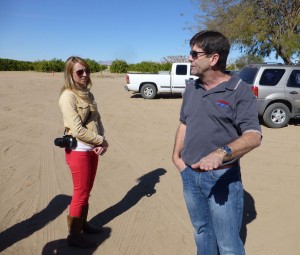
Dennis Jensen of Sea View begins our tour at a ranch growing lemons and date palms. Whitney Bond of LittleLeopardBook.com looks on.
Dennis jumped into his pick up truck and we followed him in our SUV, driving on sandy roads that looked like hiking trails through the desert. We drove directly across (and into) the “old” Coachella Canal on our way to see the beautiful “new’ canal that was built with a special concrete liner.
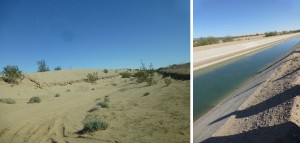
This 36 miles section of the Coachella Canal was an earthen waterway until 2006 when the new parallel concrete-lined canal was built. The water conserved by eliminated seepage helps meet urban water demand in San Diego county.
The Coachella Canal is a branch of the All-American Canal that brings water from the Colorado River to Southern California. The Coachella Canal has been considered an engineering wonder for decades because the water travels the entire length of the canal totally by gravity flow, which eliminates the cost of electricity to operate pumps. If you would like to learn more about this amazing water system, visit the Coachella Water District site about agricultural irrigation and drainage. It’s a fascinating and inspiring story!
We had seen field crops during our morning visit with Al Kalin, and our visit with Dennis Jensen would introduce us to tree crops. He told us about his experience of purchasing land and the frustrating process to determine whether his land had water rights so he could plant his trees. He was given conflicting information, but after extensive research, he used very old land documents to prove that his land was entitled to use water from the Coachella Canal. He was able to go ahead with planting citrus trees and date palms on his property. He has gradually built a business of managing farms for other owners as well as for himself, and more recently has built his own packing facility. He has marketed all of his crop in the past, but explained that this year much of his fruit will be marketed through Sunkist, a not-for-profit cooperative.
“Sunkist is the oldest continually operating citrus cooperative in America and the largest marketing cooperative in the world’s fruit and vegetable industry.”
Dennis explained that he needed to find a way to get his high quality fruit into larger grocery store chains as well as into the international markets. Some of his specialty fruits are still sold directly to markets that cater to certain ethnic populations who want kumquats, sweet limes, Seville oranges, and other fruits with lower overall demand.
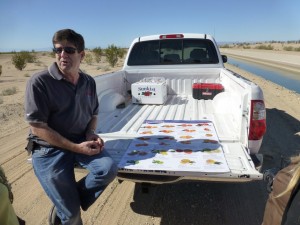
Dennis Jensen shows us a poster of different citrus variaties that he grows, packs and sells through SunKist cooperative.
As we looked out over the dry desert, we could see the Chocolate Mountains of California in the distance which are used by the Navy and Marines as an aerial gunnery range.
The water flowed past us through the beautiful new canal, bringing water to some of the most productive farm land in the world. Farming was originally done in this area with water from artesian wells, but those wells would have dried up long ago if the water in the underground aquifers had not been replenished. Some farmers still do use wells, and the water they pump through their wells from the aquifer is also managed by the Coachella Water District. (more about that later)
It is important to point out that there must also be a way to drain the water from the soil where food is growing, otherwise salts from the irrigation water will build up in the soil. This is why the fields have a system of drains that will allow the salts to be leached from the soil. This water ultimately drains into the Salton Sea, one of the world’s largest inland seas. Water from the canal is also used to recharge the aquifers (underground water storage) … but I’ll tell you more about that in Part 3.

This is a “turn out” where the water can flow from the canal to the farmland and the crops that rely on irrigation.
We stopped in several locations to see varieties of citrus: red ruby grapefruit, Mineolas, sweet limes and Valencia oranges.
We had a wonderful time with Dennis Jensen, trying some of the citrus fruits that he grows. He carries a slim fruit knife which he uses to “filet” the fruit, giving each of us perfect slices of juicy sweetness. Dennis gave us a large box to fill with fruit as well as individual bags…and he even gave us each our own fruit knife with ‘Sea View” engraved on the side.
I was amazed that so many productive farms can operate in a sandy desert! Look at the roads between the trees! It’s almost like beach sand!
Our last stop with Dennis Jensen was a date garden. The date palms are planted in straight rows, and produce dates for many years before the trees are sold as landscaping plants.
We were enchanted by the beautiful date trees, imagining an amazing wedding or party venue under the trees.
We appreciated the time Dennis Jensen gave to us, talking about the fruit that he grows and the challenges he faces as a farmer, manager and packer. Throughout the day we had been hearing about the Salton Sea , and now we would be driving north along the eastern shore to meet Peter Nelson, a farmer who is chairman of the board of the Coachella Valley Water District. By this time we had more questions for Clare Foley and Mike Wade of the California Farm Water Coalition. We were beginning to understand why the story of water and agriculture in Imperial Valley and Coachella Valley needs to be shared, so that more of us will understand and appreciate this natural treasure.
Coming Next: Our introduction to the Salton Sea, the Oasis Date Gardens and how the Coachella Valley recharges the underground aquifers


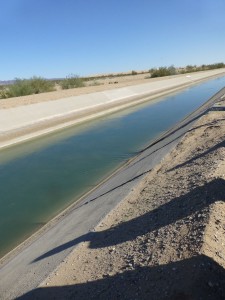
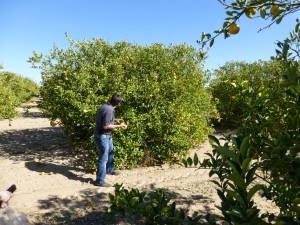
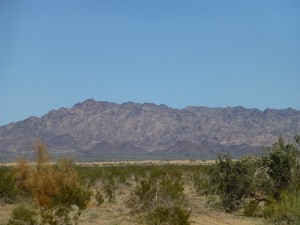
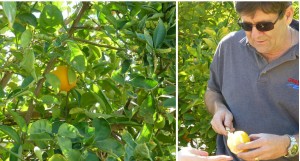
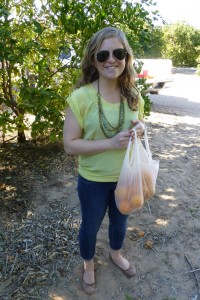
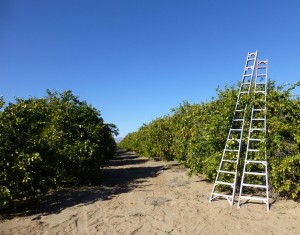
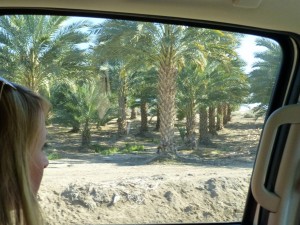
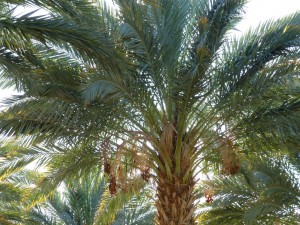
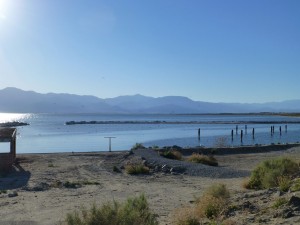
2 Comments
Leave a reply →